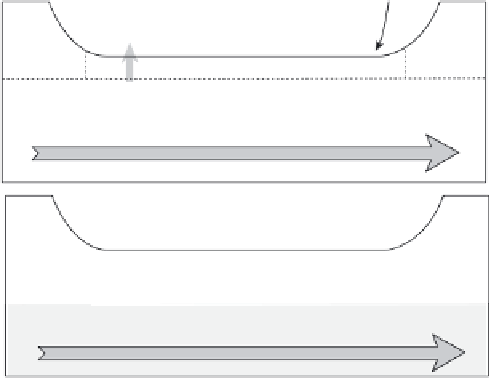Geoscience Reference
In-Depth Information
face characteristics (see Chapter 18). Important 'hotspots'
of activity have been associated with playa surfaces sus-
ceptible to saltation activity, where the impact of saltat-
ing grains can effectively break up wind-resistant crusts
(Cahill
et al.
, 1996; Nickling, McTainsh and Leys, 1999;
Gillette, Niemeyer and Helm, 2001). Local groundwater
depth and salinity have also been shown to be a funda-
mental control on dust emission. Reynolds
et al.
(2007)
found that the surface of 'wet' playas (where evaporation
from near-surface water tables is possible) might consist
of several centimetres of loose evaporite minerals highly
susceptible to wind erosion. However, they also noted how
dynamic such surfaces are, with erosion potential varying
rapidly dependent upon changing water table depth, rain-
fall and rates of evaporation (Figure 20.3).
Atmospheric controls are key to dust emission, but
many studies have found that it is the extreme and
gusty winds (rather than the mean) that correlate best
with dust emission (Engelstaedter, Tegen and Washing-
ton, 2006; Engelstaedter and Washington, 2007a; Reheis,
2006, Wiggs and Holmes, 2010). Further, some specific
dust sources appear to be supply-limited, with the amount
of material eroded being highly dependent upon the avail-
ability of erodible material rather than the erosivity of
the wind (although see the text on the
Bodele Depres-
sion, Chad
, later in Section 20.2.1). Surfaces may become
restricted in their erodibility due to a lack of available
sediment or by changing surface conditions on erodible
sediment (e.g. surface crusting). In a similar manner
to some Australian dust sources (McTainsh, Keys and
Evaporite minerals
Evaporation
Capillary fringe zone
(a)
Water table
(b)
Water table
Figure 20.2
The processes by which a near-surface water
table, effected by high evaporation rates and capillary rise,
may result in highly erodible 'fluffy' evaporate minerals on the
surface of dry lake beds (after Rosen, 1994).
(2008) noting that aeolian deposits account for 37 % of
dust sources in Australia.
The spatial and temporal sensitivity of these source ge-
omorphologies to dust emission is poorly understood. It is
apparent that dust is eroded from small 'hotspots' within
source areas and that susceptibility to emission is very
much dependent upon complex relationships that exist
between erosion potential and local surface and subsur-
High
Potential for
dust emission
Low
Ground
surface
Capillary-
fringe zone
Water table
Usually
inundated,
moist, or
crusted
Potentially fluffy,
very soft
Puffy, soft
Compact, hard
Surface
characteristics
LAKE or
WETLAND
WET PLAYA
DRY PLAYA
Setting
Figure 20.3
Theoretical relationship between dust emission, thickness of the capillary fringe zone and playa surface characteris-
tics. The schematic shows the likely sensitivity of surface erodibility to minor changes in water table depth (after Reynolds
et al.
,











